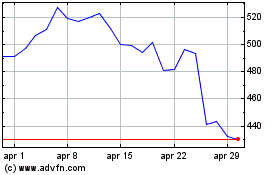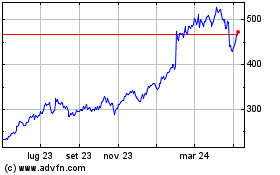Meta and Snap Shares Climb as FCC Seeks Ban on TikTok
07 Novembre 2022 - 2:33PM
Finscreener.org
Earlier this week, shares of
social media companies such as Snap
(NYSE:
SNAP) and Meta (NASDAQ:
META) gained pace after
the Federal Communications Commission (FCC) said the U.S.
government should ban TikTok, a China-based short-video
platform.
In an interview with Axios,
Republican Commissioner Brendan Carr claimed, “I don’t believe
there is a path forward for anything other than a ban."
According to a CNBC report, “The
Committee on Foreign Investment in the U.S. (CFIUS) in the Treasury
Department is reviewing the company’s (TikTok’s) potential national
security implications, given its ownership by a Chinese company,
ByteDance.”
There have been concerns over
data security risks associated with TikTok, and the government
administration in the U.S. has again raised this issue. However,
TikTok has confirmed it does not store the user data of its U.S.
customers in China.
TikTok has gained significant traction
TikTok initially revealed its
user details back in 2020 when the company challenged another ban
from the U.S. two years back. The TikTok platform was launched in
2017, and it managed to acquire 11 million users in the United
States by January 2018. This number rose to 27 million in the next
12 months and soared to 91 million by June 2020.
Comparatively, its monthly active
users globally rose from 85 million in Q1 of 2018 to a staggering
1.46 billion by Q2 of 2022. The company attracted 138 million users
from North America by the end of 2021.
TikTok was banned by India in
2020, which was one of its largest markets, as tensions between
China and India rose at the onset of COVID-19.
TikTok’s rising popularity has
shifted digital ad spending towards the platform and away from
Snapchat and Instagram. Due to TikTok’s rising competition, a
challenging macro-environment, and privacy changes from Apple,
revenue for Meta and Snap have decelerated at a rapid pace this
year.
In fact, Meta reported
two consecutive quarters
of revenue decline in Q3 as its
sales fell to $27.71 billion in the September quarter from $33.6
billion in Q4 of 2021. Analysts now expect
Meta’s sales to fall by 1.1% to
$116.6 billion in 2022, which will be the first year-over-year
decline for the social media giant.
Similarly, after sales soared by
more than 50% to $4.11 billion in 2021 for Snap, analysts expect
top-line growth to decelerate to just 12% in 2022 and to 9.2% in
2023.
Due to these reasons, Meta stock
and Snap stock are down 76% and 88%, respectively, below all-time
highs.
Can Snap and Meta stock make a comeback in the near
term?
Both Meta and Snap will need to
improve engagement rates on their platforms as they face growing
competition from the latest entrant on the block. Further, an
uncertain ad market and an inflationary environment, including
rising interest rates, will remain near-term challenges as
enterprises are likely to face a global recession in
2023.
The cracks on the Facebook wall
first appeared in late 2021 when the platform lost a million daily
active users in Q4 of last year. Loup Ventures managing partner
Gene Munster had then warned a drop in user growth would send a
shockwave to investors, and Meta
stock has consistently declined in the first ten months of
2022.
Brands are not motivated to
invest in ad placements in recent months as lagging supply chain
lead times have lowered ad budgets. Companies are not willing to
market products if these items are not going to hit retail
shelves.
It is going to be a rocky ride
for investors of Snap and Meta as these headwinds are unlikely to
abate in 2023.
Grafico Azioni Meta Platforms (NASDAQ:META)
Storico
Da Mar 2024 a Apr 2024

Grafico Azioni Meta Platforms (NASDAQ:META)
Storico
Da Apr 2023 a Apr 2024
